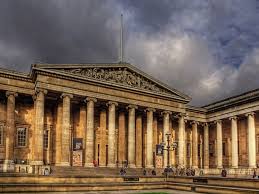BRITISH MUSEUM
British Museum is world’s largest receiver of stolen goods, says QC
Geoffrey Robertson says it should ‘wash its hands of blood and return Elgin’s loot’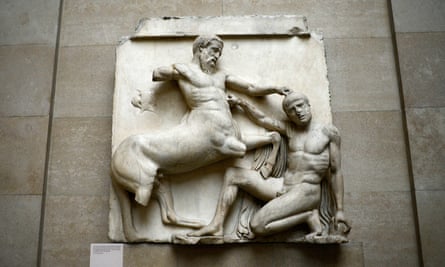 Part of the Parthenon or Elgin marbles at the British Museum in London. Photograph: Dylan Martinez/ReutersDalya Alberge
Part of the Parthenon or Elgin marbles at the British Museum in London. Photograph: Dylan Martinez/ReutersDalya Alberge
The Guardian, Mon 4 Nov 2019 14.41 GMT
The British Museum has been accused of exhibiting “pilfered cultural property”, by a leading human rights lawyer who is calling for European and US institutions to return treasures taken from “subjugated peoples” by “conquerors or colonial masters”.
Geoffrey Robertson QC said: “The trustees of the British Museum have become the world’s largest receivers of stolen property, and the great majority of their loot is not even on public display.”
He criticised the museum for allowing an unofficial “stolen goods tour”, “which stops at the Elgin marbles, Hoa Hakananai’a, the Benin bronzes and other pilfered cultural property”. The three items he mentioned are wanted by Greece, Easter Island and Nigeria respectively.
“That these rebel itineraries are allowed is a tribute to the tolerance of this great institution, which would be even greater if it washed its hands of the blood and returned Elgin’s loot,” Robertson said.
He accused the museum of telling “a string of carefully-constructed lies and half- truths” about how the marbles “were ‘saved’ or ‘salvaged’ or ‘rescued’ by Lord Elgin, who came into possession of them lawfully.”
He criticised “encyclopaedic museums” such as the British Museum, the Louvre in Paris and the Metropolitan in New York that “lock up the precious legacy of other lands, stolen from their people by wars of aggression, theft and duplicity”.
Robertson’s views appear in his book, Who Owns History? Elgin’s Loot and the Case for Returning Plundered Treasure.
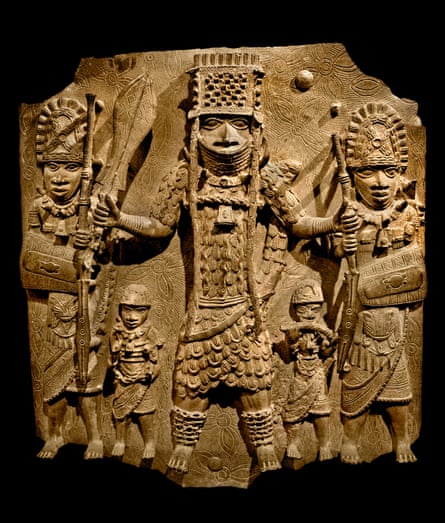
Bronze plaque showing the Oba of Benin, 16th century. Photograph: Alamy
He writes: “This is a time for humility – something the British, still yearning for the era when they ruled the world, ie for Brexit, do not do very well. Before it releases any of its share of other people’s cultural heritage, the British Museum could mount an exhibition – ‘The Spoils of Empire’.” Others argue that the empire also brought benefits, including education and legislation.
Advocating the return of cultural property based on human rights law principles, Robertson observes that the French president, Emmanuel Macron has “galvanised the debate” by declaring that “African cultural heritage can no longer remain a prisoner of European museums”.
“Politicians may make more or less sincere apologies for the crimes of their former empires, but the only way now available to redress them is to return the spoils of the rape of Egypt and China and the destruction of African and Asian and South American societies,” he writes.
“We cannot right historical wrongs – but we can no longer, without shame, profit from them.”
Robertson prepared a report on the reunification of the Elgin marbles for the Greek government with Amal Clooney and the late Professor Norman Palmer. In his new book, he acknowledges that restitution might well encourage further claims, “although – because the Marbles are unique – not necessarily successful ones”.
He writes: “The Benin bronzes, for example, are art which is important to Africa, but not to the world in the way that the marbles have international resonance. On the other hand, the barbaric manner of the taking of the bronzes amounted to a war crime, which is morally more despicable than Elgin’s theft and duplicity.”
He accuses museum trustees and the government of passing the buck when it comes to answering requests for the return of cultural property. He also criticises the lack of diversity among trustees.
Julian Spalding, the former head of Glasgow, Sheffield and Manchester museums, agreed that the British Museum should give the Elgin marbles back “because they’re an intrinsic part of one the world’s greatest works of art”.
A British Museum spokeswoman confirmed that it allows a “stolen goods tour”, run by an external guide. She said the Elgin marbles were acquired legally, with the approval of the Ottoman authorities of the day.
“They were not acquired as a result of conflict or violence. Lord Elgin’s activities were thoroughly investigated by a parliamentary select committee in 1816 and found to be entirely legal,” she said.
“The British Museum acknowledges the difficult histories of some of its collections, including the contested means by which some collections have been acquired such as through military action and subsequent looting … In the case of the Benin bronzes, the museum visited Benin City in 2018 to talk about plans for a new Royal Museum in Benin City and how the museum could help.”
Source: The Guardian, 04.11.2019, Dalya Alberge
UK museums should be honest about being stuffed with stolen goods
Institutions need to be transparent about their legacies of imperialism and theft – and confront the issue of repatriation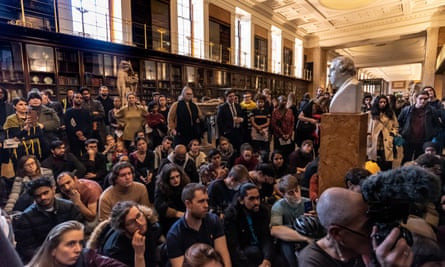
‘People are tired of repatriation being an untouchable subject.’ Campaigners attend a tour of the British Museum calling for the return of stolen cultural objects last year. Photograph: Zuma Press, Inc/AlamyWed 20 Feb 2019 16.06 GMT
Museums are in crisis. In the past, their social role has been taken for granted – they’re spaces for preserving objects and educating the deferential public that comes to admire them. It’s a tidy, completist dream: wouldn’t it be nice to see the whole of human history, free and open to all?
Except that history is nasty and ugly. It’s full of violence: every moment, every event, takes place within a power dynamic – there’s always a hierarchy in play.
The whole concept of The Museum is a colonialist, imperialist fantasy, born from the fallacy that somehow the whole world can be neatly catalogued, contained in a single building, mapped out for easy digestion. There’s no such thing as a free object, and every piece in a museum has been moved from its original context. It’s uncomfortable and rude to look too closely at what that move involved.
But people are tired of not looking too closely. Last weekend, at least 300 people occupied the British Museum to protest against their continuing partnership with BP. They’re all tired of museums being unquestionable, unethically funded pleasure houses where dirty money gets made to look like shiny civic pride. In the past year, nearly 2,000 people have attended my Uncomfortable Art Tours and taken part in a conversation about power and national identities in these spaces. They’re all tired of repatriation being an untouchable subject, something museums only comment on when they’re forced to.
I run these unauthorised events in an attempt to fill in the gaps the museums refuse to acknowledge: when they don’t address the theft and imperial legacies that created their collections, someone has to step up and provide that information. We’re tired of selective histories and half-truths. We’re tired of institutions holding all the cards, setting impossible targets of proving “cultural continuity” before they’ll consider a repatriation request, of insisting that illegally acquired and largely ignored ancestral remains must be kept in case they suddenly come in handy for a hypothetical research project.
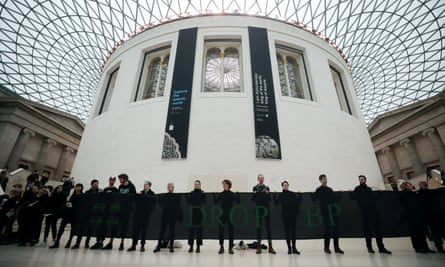
‘Last weekend, at least 300 people occupied the British Museum to protest against their continuing partnership with BP.’ Photograph: Hannah McKay/Reuters
Earlier this week, the Guardian published the responses of some major museums to requests for repatriation. These freedom of information requests reveal anxious institutions, paranoid to the point of hostility, totally unable to see that by continually refusing to take repatriation seriously they’re becoming ridiculous. I’m sick of the idea that if a museum returns one item to its community of origin, their collection will empty overnight, and the only alternative to destroying all museums forever is to keep them exactly as they are, beyond all reproach. It’s a false binary, one that ignores cultural nuances and lumps all First Nations and post-imperial communities together into some kind of greedy horde clawing at the door.
Not everyone is asking for their property back: there are plenty of artefacts that weren’t stolen or illegally acquired. Those unreturned collections can still tell the story of human history – it might be a bit more locally focused, but there will still be stories of trade and networks of power. It’s fine. You’ll still have museums.
First, though, those museums have to change. They can’t be these cold, possessive spaces any more. We need a new type of museum: one that’s not afraid to admit it doesn’t have all the answers and actually welcomes critique and dissent, that will let in a multiplicity of responses and voices without defensiveness. We need a different script on acquisition, possession and repatriation: it’s not enough to insist that finders are keepers, or to hide behind outdated acts that don’t actually prevent the disposal of objects.
So of course museums are on the defensive, it’s hard when people don’t trust you. The individuals who work in these collections might be trying their best to represent the histories they contain as well and as fairly as possible. I want to believe that. But as long as the we-know-best-don’t-ask-questions tone continues, good intentions are nowhere near enough.
What would it take to get us to the point of real transparency? Give us a reason to trust you: show us your records (and not in some labyrinthine catalogue), show us what you have and where it comes from.
Let us look at these objects you so desperately don’t want to let go of, and show us your case for keeping them. Let people respond, and actually hear the hurt and harm that your collections perpetuate. Admit what’s being contested instead of just pretending it’s all OK.
Provenance is part of the story, and audiences are hungry to hear it. We’re in a decisive moment, as pressure mounts from campaigners, governments and visitors. The “repatriation issue” isn’t going away. This isn’t a cute new trend – eventually there will be a transformation, like it or not. This atmosphere of awkward denial and compromise can’t last much longer. It’s well past time for museums to tell the whole story.
• Alice Procter is an independent tour guide and art historian based at University College London
Should museums return their colonial artefacts?
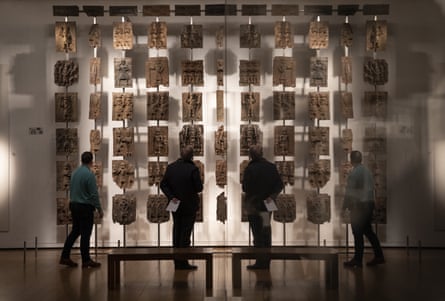
Some of the Benin bronzes at the British Museum in London. Photograph: Dan Kitwood/Getty Images
Europe’s museums serve a nuanced purpose and shouldn’t automatically bow to calls to return artworks plundered by 19th-century colonisers, writes V&A director Tristram Hunt Sat 29 Jun 2019 14.00 BST
“I am from a generation of the French people for whom the crimes of European colonialism are undeniable and make up part of our history,” announced Emmanuel Macron to a crowded lecture theatre at Ouagadougou University, in Burkina Faso, in November 2017. “I cannot accept that a large part of cultural heritage from several African countries is in France … In the next five years, I want the conditions to be created for the temporary or permanent restitution of African patrimony to Africa.” In case anyone missed the significance of the French president’s remarks, the Elysée Palace was swift to spell out the new policy: “African heritage can no longer be the prisoner of European museums.”
The following year brought another notable intervention, this time from supervillain Erik Killmonger in the Marvel blockbuster Black Panther. Surveying the African collection at the “Museum of Great Britain”, Killmonger corrects the exhibition’s patronising white curator about the provenance of an axe: “It was taken by British soldiers in Benin, but it’s from Wakanda. Don’t trip – I’m gonna take it off your hands for you.” When the woman replies that the items are not for sale, Killmonger says: “How do you think your ancestors got these? Do you think they paid a fair price? Or did they take it, like they took everything else?” As the poisoned curator collapses, Killmonger deaccessions the artefact. Black Panther took just 26 days to reach $1bn (£784,000) in worldwide box office sales and, in one compelling scene, highlighted all the current controversies over museum collections and colonial injustice.
Macron’s pledge and Killmonger’s heist had context. The preceding decade had brought growing demands for the restitution of artefacts taken from Africa by European colonists during the 19th century. If the case for the restitution of human remains to indigenous communities had been, by and large, acceded, the new frontier was works of art. The UN kickstarted the conversation in 2007 with article 11 of its declaration on the rights of indigenous peoples, which urged states to restore “cultural, intellectual, religious and spiritual property” taken from indigenous people without their “free, prior and informed consent or in violation of their laws, traditions and customs”. With that aim in mind, the Benin Dialogue Group was established the same year as part of an effort to get European museum curators talking to key representatives in Nigeria.

Action soon followed. In 2009, Egypt demanded that the Louvre return five fragments of a wall painting from the tomb of Tetaki, an 18th-dynasty noble. In 2012, Nigeria requested the return of 32 objects from the Museum of Fine Arts, Boston that had been looted by the British army during a raid on the Royal Palaces of Benin City in 1897. In 2017, a year after the president of Benin had made an official request to the French foreign ministry for the return of items taken during imperial occupation, Nigeria made a further request, asking the British Museum in London to return the celebrated Benin bronzes.
A core objective of the Benin Dialogue Group was the creation of a permanent display in Benin City of objects once belonging to the former kingdom and now in continental hands. Last year, Hermann Parzinger, president of the Prussian Cultural Heritage Foundation, called for international guidelines akin to the Washington principles (which address the restitution of Nazi-confiscated art to descendants of dispossessed, predominantly Jewish families) to help museums handle provenance research and repatriation of illegally acquired artworks in public collections. It is no coincidence that much of this thinking coincided with growing calls for western European nations to apologise for various “crimes” of empire, from the Germans in Namibia and the Dutch in Indonesia to the British in Kenya and India and the French in north Africa.
However, it was Macron’s intervention that signalled a step change. “This is a revolution,” declared French art historian Bénédicte Savoy. “In two minutes and 33 seconds… Macron swept aside several decades of official French museum policy.” Savoy was appointed, alongside the Senegalese economist and writer Felwine Sarr, to write a report on implementing the Macron vision. The resulting study, published last November, recommended the restitution of “any objects taken by force or presumed to be acquired through inequitable conditions” by the army, scientific explorers or administrators during the French colonial period in Africa, which lasted from the late 19th century until 1960.
In the report’s aftermath, museums across Europe raced to develop new policies on restitution and repatriation – not least at the Victoria and Albert Museum. Having previously worked as an MP, I am used to politics. But since my appointment as director of the V&A in February 2017, I have been taken aback by the intensity of the repatriation debate. As a museum born of the imperial moment, the question of provenance and ownership in a post-colonial age is particularly germane. The V&A’s collections expanded in line with the growth of the British empire, in its official and unofficial guise, across southern Asia, showcasing Indian textiles, Burmese lacquerware, Chinese porcelain, and Persian carpets – as well as a remarkable range of British industrial designs and European Renaissance treasures. In Britain’s colonies and spheres of influence, the practice of collecting was intimately tied to the dominating psychology of colonialism. From the beginning of my directorship, I wanted to be open and transparent about that colonial past, and think carefully about how to manage its legacy today. So too did colleagues on the continent.
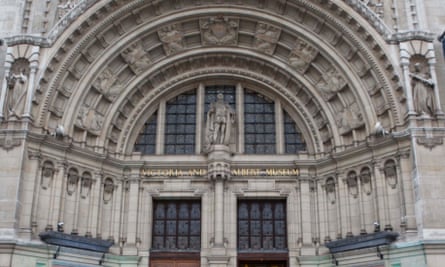
The Victoria and Albert Museum. Photograph: Katherine Anne Rose/The Observer
“It’s a disgrace that the Netherlands is only now turning its attention to the return of the colonial heritage,” Taco Dibbits, the Rijksmuseum’s director, told the Dutch newspaper Trouw as he opened talks on the restitution of colonial-era loot to Indonesia and Sri Lanka. “We should have done it earlier and there is no excuse.” Similarly, the Netherlands’ National Museum of World Cultures pledged proactively to return all artefacts within its collection identified as stolen during the colonial era – starting with 139 Benin bronzes, eligible for repatriation to Nigeria. Just outside Brussels, in Tervuren, the Royal Museum for Central Africa turned itself from an institution that celebrated the colonial history of Belgium in the Congo to one that consciously confronted the multiple crimes of King Leopold’s African empire. As parks in eastern Europe are dotted with the fallen statues of Stalin and Lenin, so the Brussels museum pulled down its highly racialised and offensive African statuary (placing them on show as a relic of European colonial thought). And in Berlin, Germany’s 16 state cultural ministries, the foreign office, and urban municipalities agreed to work with museums on a set of guidelines for the return of objects taken from former colonies. “All people should have the opportunity to meet their rich material cultural heritage in their countries and communities of origin, to interact with it and pass it on to future generations,” they concluded.
At the same time, an exciting wave of new museums was announced across Africa. The Museum of Black Civilisations in Dakar, Senegal, was opened in 2018, with capacity for about 18,000 objects, alongside a clear demand for some of that space to be filled by items currently housed in European museums. New projects are also scheduled for the Javett Art Centre at the University of Pretoria, the Museum of National History in the Democratic Republic of the Congo and the JK Randle Centre for Yoruba Culture and History in Lagos. The opening of the Benin Royal Museum in Benin City is scheduled for 2021.
The Macron intervention and Savoy/Sarr report represent a philosophical disavowal of the bullish defence of western, encyclopaedic museums articulated in the 2002 “declaration on the importance and value of universal museums”, signed by 18 prominent institutions including the Louvre and New York’s Metropolitan Museum. When it came to the troubled provenance of parts of their collection, the declaration decreed that “over time, objects so acquired – whether by purchase, gift or portage – have become part of the museums that have cared for them, and by extension part of the heritage of the nations which house them”. James Cuno, president of the J Paul Getty Trust, fleshed out the argument for world collections in his book Museums Matter, writing: “Without [encyclopaedic museums], one risks a hardening of views about one’s own, particular culture as being pure, essential, and organic, something into which one is born… The collective, political risk of not having encyclopaedic museums… is that culture becomes fixed nationalculture.” Cuno thought it highly reductive to condemn a collection solely because of an imperial connection, adducing Edward Said’s argument that “partly because of empire, all cultures are involved in one another; none is single and pure, all are hybrid, heterogenous, extraordinarily differentiated, and unmonolithic.”
This nuanced account of the impact of empire represents an increasingly singular stance amid the increasingly vocal public and professional campaign to “decolonise the museum”. In a 2016 TedX talk on the latter theme, Cinnamon Catlin-Legutko, president and CEO of the Abbe Museum in Maine, urged fellow museum professionals to give voice and power back to formerly colonised people in an effort to make colonial histories more present in western museums. Olga Viso, the director of Minnesota’s Walker Art Center, concurred. “If museums want to continue to have a place, they must stop seeing activists as antagonists,” she wrote. “They must position themselves as learning communities, not impenetrable centres of self-validating authority. If they do not, museums run the risk of becoming culturally irrelevant artefacts.”
The debate was further energised in April 2018, when Brooklyn Museum hired a white scholar as consulting curator of African art.
An open letter from Decolonize This Place, a New York-based action group intent on an overhaul of the city’s museums, described the decision as “tone deaf”, calling on the museum to “participate in the creation of a Decolonization Commission… to account for their own role in the histories of colonialism and white supremacy”. The group called for this commission to be tasked with diversifying the museum’s staff and reviewing its inventory of colonial-era artefacts “with a view to settling the long-pursued claims of reparations and repatriation”.
Curiously, yet tellingly, Decolonize This Place also sought an end to “pro-Israeli artwashing” and “an institutional commitment to address the issues raised by the boycott, divestment, and sanctions movement” against Israel. What the establishment of the state of Israel had to do with the hiring of a white female curator in Brooklyn was unclear, but it exposed both the broader ideological (and racial) agenda of the movement and how the ‘decolonisation’ agenda can encompass so many differing strands.
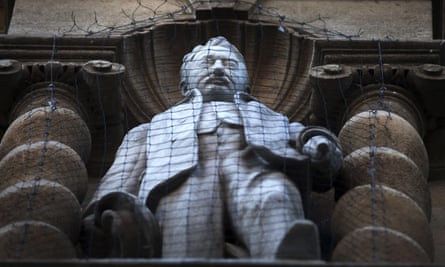
in 2016, Oxford University students unsuccessfully called for the removal of a statue of Cecil Rhodes outside Oriel College.
There have been debates around the imperial past and its legacies in Britain, one example being the Rhodes Must Fall campaign, which called for the removal of a statue of Cecil Rhodes from an Oxford college. But while the call to decolonise museums is at an earlier stage than in the US, it is gathering pace. Birkbeck, University of London historian Emma Lundin has written of how “Rhodes must go, along with objects brought to Britain by colonial-era travellers” and urges the return of “purchased objects… acquired because of power imbalances between buyers and sellers”. Alice Procter, a University of London student, runs “uncomfortable art tours” of British museums focusing on questions of disputed provenance. She dismisses “the whole concept of the Museum… [as] a colonialist, imperialist fantasy, born from the fallacy that somehow the whole world can be neatly catalogued, contained in a single building, mapped out for easy digestion”. Clearly to her, the museum as well as Rhodes must go.
In 2016, a group of museum and heritage professionals formed Museum Detox, a network for people of black, Asian, Arabic or dual heritage. Led by Sara Wajid, head of engagement at the Museum of London, they aim to build awareness about diversity in cultural organisations, help members achieve leadership positions, and “creatively use radical approaches to dismantle unjust infrastructures in our national cultural institutions”. While numerous museums have, over many decades, addressed uncomfortable colonial histories through their events, last year Birmingham Museum and Art Gallery went further. Its exhibition The Past Is Now: Birmingham and the British Empire, which was conceived as “an experiment in how the story of the British empire may be told permanently”, brought together six external co-curators of colour from outside the museum world. “For many people of colour, collections symbolise historic and ongoing trauma and theft,” explained Sumaya Kassim, one of the artists involved. “The craftsmanship, the display case, the beauty of the institution that collects and protects its imperial hoard: the way items are described, the way they are catalogued and what gets shown and what remains hidden; all work to deny, retreat and forget.”
Despite much outside praise, the exhibition also drew criticism for giving the impression that “the British empire was unfailingly dreadful and uniquely evil”. More interestingly, those involved in its curation worried whether the exhibition had merely endorsed the status quo. “I do not want to see decolonisation become part of Britain’s national narrative as a pretty curio with no substance,” wrote Kassim. The fear was that “decoloniality” was already on its way to becoming a buzzword devoid of agency, like “diversity”. The cultural critic Jason Farago similarly urged western, encyclopaedic museums to go beyond inclusion, diversity, and even “decolonisation”, to rethink completely their approach. “A 21st-century universal museum has to unsettle the very labels that the age of imperialism bequeathed to us: nations and races, east and west, art and craft. It’s not enough just to call for ‘decolonisation’… the whole fiction of cultural purity has to go, too. Any serious museum can only be a museum of our entangled past and resent.”
How should an institution like the V&A respond to this new cultural climate, and honour its responsibilities as a global museum? Last year, on the 150th anniversary of the British invasion of Abyssinia, we attempted to chart a pathway through with a small display highlighting our imperial, Ethiopian collections. At its heart sat the Maqdala crown, an exquisite work of African craftsmanship, commissioned by the Ethiopian Empress Mentewab in the 1740s, alloyed with silver and copper with filigree work and glass beads. But, as the display made clear, the crown came into the V&A’s possession in less pretty circumstances.
Its route to South Kensington originated with the mid-19th century Abyssinian ruler, Emperor Tewodros II, and his ambition to build a modern nation state in east Africa. As a great Christian emperor, Tewodros hoped to push back the power of the Egyptians and sought the assistance of Queen Victoria and the British state in his endeavours. When Lord Palmerston revealed he had no intention of supporting his ambitions (not least because it might entail alienating Egypt, a major supplier of cotton), Tewodros took hostage the British emissary and a handful of European nationals. In response, Sir Robert Napier gathered together an expeditionary force of 13,000 men, stormed the Maqdala fortress, secured the release of the hostages, and then started to pillage. Sometime during the battle, Tewodros killed himself.
Under the stewardship of accompanying curator Richard Holmes, the crown, chalice, and other regalia made their way back to the British Treasury, were auctioned for the army prize fund and then transferred to numerous national museums, including the V&A. Many British politicians heralded the Abyssinian expedition as a textbook imperial intervention. But William Gladstone, the prime minister, told the House of Commons that he “deeply lamented, for the sake of the country, and for the sake of all concerned, that these articles… were thought fit to be brought away by a British army”. He urged that they “be held only until they could be restored”.

A crown from the Maqdala 1868 exhibition at the V&A Museum. Photograph: V&A
During the 20th century, a number of items held by the British government were returned to Ethiopia. Artefacts owned by the British Museum, British Library, National Army Museum and V&A could not legally be part of that process of restitution, however. So in March 2008, Girma Wolde-Giorgis, the president of Ethiopia, sent a letter to Sir Mark Jones, the V&A’s director at the time, stating that Ethiopians had “long grieved at the loss of this part of their national heritage” and urging “the return of Ethiopia’s looted treasures” “to cement the good relations between our two countries”. Yet discussions over how to pursue such an accommodation soon petered out. In 2018 we were clear that even if the objects could not be returned tout court, we should nonetheless work on a display as well as being open and transparent about how the items entered the collection, engaging with the Ethiopian embassy and the broader diaspora community, and offering the items on a long-term loan. If not decolonising the museum, the display was cognisant of the colonial context of the collection and its meaning for African-heritage communities.
Adamant that the restitution case remained outstanding, the Ethiopian government said they could not accede to a long-term loan, as that would signal a legal acceptance of UK ownership. “Ethiopia’s demand has always been the restoration of those illegally looted treasures. Not to borrow them,” responded Ephrem Amare, the Ethiopian National Museum director. That position was reaffirmed in March 2019 when the Ethiopian culture minister, Dr Hirut Kassaw, visited the V&A display. For the Ethiopian government, the collection was not simply an array of interesting design artefacts, but essential to the country rediscovering its history and charting a new way forward. Kassaw’s trip to London included a successful visit to the National Army Museum, where she oversaw the return of two lockets of hair cut from the scalp of Tewodros in 1868 and now set to be reinterred with his remains.
Alongside the understandable official position, the Ethiopian ambassador Hailemichael Aberra Afework expressed satisfaction “with the new partnership between Ethiopia and the V&A”, expressing optimism about “future co-operation” on “the care and maintenance of cultural heritage, in which the V&A has extensive experience”. Productive conversations have since been held about a framework for co-operation – together with the British Library and British Museum – and we are working towards having the Maqdala treasures on show in Addis Ababa.
The V&A’s Maqdala experience highlighted the tensions facing national museums when it comes to restitution debates. Under the National Heritage Act 1983, the trustees of the V&A are specifically prevented from de-accessioning objects that are the property of the museum, unless they are exact replicas or damaged beyond repair. This remit was specifically enjoined to prevent the dispersal of “unfashionable” items from the collections (or, indeed, fundraising through the sale of valuable works), which later generations might have lamented.
But legislation is only part of the issue. I also feel we need to tread carefully along a path of total restitution, dictated by a political timetable. There remains something essentially valuable about the ability of museums to position objects beyond particular cultural or ethnic identities, curate them within a broader intellectual or aesthetic lineage, and situate them within a wider, richer framework of relationships while allowing free and open access, physically and digitally.
For a museum like the V&A, to decolonise is to decontextualise: the history of empire is embedded in its meaning and collections, and the question is how that is interpreted. A more nuanced understanding of empire is needed than the politically driven pathways of Good or Bad. For alongside colonial violence, empire was also a story of cosmopolitanism and hybridity: through trade, religion, war and force, peoples and cultures mixed and, in many cases, expressed that exchange and interaction through the type of material culture now found in museums. That was the case for the Roman, Ottoman, Ming, Ashanti, Habsburg and, yes, British empires. Today, power, wealth and art are being accumulated in the coming empires – informal and formal – of modern China and the Gulf states. Perhaps the real challenge is how we create more, rather than fewer, universal museums – not in Europe and the west, but across Africa, India and the global south. Our aim should be to detach the universal, encyclopaedic museum from its colonial preconditions and reimagine it as a new medium for multicultural understanding.
Calls for “decolonisation”, restitution and diversity look set to grow. Maqdala 1868 was a small step forward. So too our work on African heritage tours of the museum collections, research into the slave-owning wealth of early V&A benefactors, programming and exhibitions consciously focused on promoting diversity, sustained attempts to widen the talent pool of curatorial and conservation staff. About 47% of schoolchildren who visited the V&A in 2017-18 were from BAME backgrounds; clear progress has been made. However, the truth is that museum leaders must engage with this agenda and work on programmes of tangible change involving collections and curators, which can include the option of repatriation, in different forms, based on the history of each object. As Sabyasachi Mukherjee, director general of the Chhatrapati Shivaji Maharaj Vastu Sangrahalaya in Mumbai, says: “Museums must recognise that unresolved repatriation and restitution disputes can, in the absence of serious efforts at conciliation, paralyse the sharing of significant cultural objects… institutional narratives or legal doctrines [must] not come in the way of celebrating a world culture.” If that is ignored, the momentum will pass into the hands of politicians – and in a two-minute-33-second speech, the complex, layered meaning of an object could be lost for ever to the reductive expediency of a passing agenda.
• This article was amended on 3 July 2019 to correct the Brooklyn Museum title from chief curator of the African collection to consulting curator of African art.



